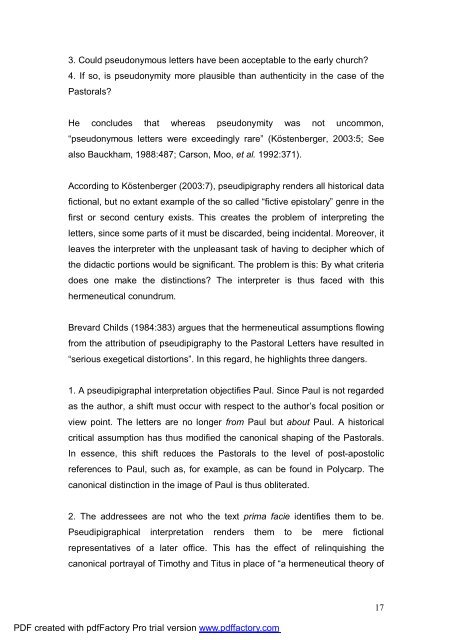A Text centred rhetorical analysis of Paul's Letter to Titus
A Text centred rhetorical analysis of Paul's Letter to Titus
A Text centred rhetorical analysis of Paul's Letter to Titus
You also want an ePaper? Increase the reach of your titles
YUMPU automatically turns print PDFs into web optimized ePapers that Google loves.
3. Could pseudonymous letters have been acceptable <strong>to</strong> the early church?<br />
4. If so, is pseudonymity more plausible than authenticity in the case <strong>of</strong> the<br />
Pas<strong>to</strong>rals?<br />
He concludes that whereas pseudonymity was not uncommon,<br />
“pseudonymous letters were exceedingly rare” (Köstenberger, 2003:5; See<br />
also Bauckham, 1988:487; Carson, Moo, et al. 1992:371).<br />
According <strong>to</strong> Köstenberger (2003:7), pseudipigraphy renders all his<strong>to</strong>rical data<br />
fictional, but no extant example <strong>of</strong> the so called “fictive epis<strong>to</strong>lary” genre in the<br />
first or second century exists. This creates the problem <strong>of</strong> interpreting the<br />
letters, since some parts <strong>of</strong> it must be discarded, being incidental. Moreover, it<br />
leaves the interpreter with the unpleasant task <strong>of</strong> having <strong>to</strong> decipher which <strong>of</strong><br />
the didactic portions would be significant. The problem is this: By what criteria<br />
does one make the distinctions? The interpreter is thus faced with this<br />
hermeneutical conundrum.<br />
Brevard Childs (1984:383) argues that the hermeneutical assumptions flowing<br />
from the attribution <strong>of</strong> pseudipigraphy <strong>to</strong> the Pas<strong>to</strong>ral <strong>Letter</strong>s have resulted in<br />
“serious exegetical dis<strong>to</strong>rtions”. In this regard, he highlights three dangers.<br />
1. A pseudipigraphal interpretation objectifies Paul. Since Paul is not regarded<br />
as the author, a shift must occur with respect <strong>to</strong> the author’s focal position or<br />
view point. The letters are no longer from Paul but about Paul. A his<strong>to</strong>rical<br />
critical assumption has thus modified the canonical shaping <strong>of</strong> the Pas<strong>to</strong>rals.<br />
In essence, this shift reduces the Pas<strong>to</strong>rals <strong>to</strong> the level <strong>of</strong> post-apos<strong>to</strong>lic<br />
references <strong>to</strong> Paul, such as, for example, as can be found in Polycarp. The<br />
canonical distinction in the image <strong>of</strong> Paul is thus obliterated.<br />
2. The addressees are not who the text prima facie identifies them <strong>to</strong> be.<br />
Pseudipigraphical interpretation renders them <strong>to</strong> be mere fictional<br />
representatives <strong>of</strong> a later <strong>of</strong>fice. This has the effect <strong>of</strong> relinquishing the<br />
canonical portrayal <strong>of</strong> Timothy and <strong>Titus</strong> in place <strong>of</strong> “a hermeneutical theory <strong>of</strong><br />
PDF created with pdfFac<strong>to</strong>ry Pro trial version www.pdffac<strong>to</strong>ry.com<br />
17

















